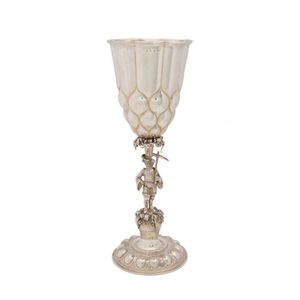Georgian Balustroid Wine Glass, c.1740
You must be a subscriber, and be logged in to view price and dealer details.
Subscribe Now to view actual auction price for this item
When you subscribe, you have the option of setting the currency in which to display prices to $Au, $US, $NZ or Stg.
- Bowl - With drinking glasses, the bowl is the hollow section of the glass that holds the liquid. Many glasses were mounted on a stem joined to a foot, others were cylindrical, of tumbler shape. The size and shape of the bowl was determined by the type of liquids they were meant to hold. Shapes used included bell shaped, conical (funnel), bucket shaped, trumpet, cup, ogee, funnel, cylindrical and rounded.
- Stem - In drinking glasses the stem is that section of the glass that joins the bowl to the foot. In mass produced glasses is usually solid and of cylindrical shape, but in antique drinking glasses it may be long and short and in various styles or with decoration, such as air twist, baluster, collared, faceted, hollow, knopped, teardrop, twisted or incised.
- Georgian - As an English stylistic period, Georgian is usually taken to cover the period from George I (1714) to the Regency of Prince George (1811-20), although the period from 1800 to 1830 is sometimes designated as the Regency period. During the Georgian period the great English cabinetmakers and designers such as Chippendale, Hepplewhite, Adam Sheraton etc., were all active.
Therefore there isn't a single 'Georgian style' as such and to say something is 'Georgian', usually means it was made between 1714 and 1830. This assumes we discount George V and George VI, both being from the 20th century.
The styles popular at the time of each reign were:
George I (1714-1727) saw out the last years of the Baroque period.
George II (1727-1760) reigned during the Rococo period.
George III (1760-1820) saw the last gasp of the Rococo, all of the early Neo-Classic 'Adam style' and most of the later neo-Classic 'Regency style'.
George IV (Prince Regent 1820-1830)encompassed the last of the 'Regency' style.
William IV's reign (1830-1837) was something of a no man's land (stylistically) and he wasn't a 'George' anyway. He covered the last glimmerings of 'Regency' and the start of the 'Victorian' style. - A/f, as Inspected - The letters "A/F" or "as inspected" as part of a description is the cataloguer's shorthand for "all faults" or "as found", meaning the item has some type of damage or deficiency, it is of uncertain date or provenance, and/or that the seller takes no responsibility for the completeness of the item or the accuracy of the description.
This item has been included into following indexes:
Visually similar items

A 16th century style sterling silver lobed chalice with Berthold Muller's import marks for London 1911, the stem in the form of William Tell, maker's mark of Ludgwig Neresheimer & co, Hanau marks. 28 cm high, 375 grams

Two Georgian air twist drinking glasses c.1750 - 1760. Height 15.8 cm & 20 cm

A Royal Doulton commemorative glass goblet. 1982. Designed to celebrate the birth of H.R.H Prince William of Wales the flute with an inscription to one roundel and the rose of England to the other, and having an internal spiral motif to the stem; stencil m

A fine Newcastle goblet, circa 1740 the round solid based funnel bowl Dutch engraved with Het Aanstande Huwelyr and depicting naval motifs, supported on a stem with shoulder annular and cushioned beaded central baluster terminating in a plain foot, 18 cm h
